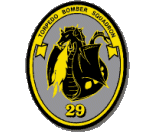Sea Control
Squadron TWENTY NINE [VS-29]
"Dragonfires"
 Two
of the US Navy's West Coast S-3B squadrons, VS-29
and VS-38, were disestablished in ceremonies at NAS
North Island, California, on 17 April 2004. The
Navy's S-3B Sundown Plan calls for the gradual
disestablishment of Viking squadrons as the number
of operational carrier-based squadrons flying the
F/A-18E/F increases. The F/A-18 will take over the
aerial tanking role from the S-3.
Two
of the US Navy's West Coast S-3B squadrons, VS-29
and VS-38, were disestablished in ceremonies at NAS
North Island, California, on 17 April 2004. The
Navy's S-3B Sundown Plan calls for the gradual
disestablishment of Viking squadrons as the number
of operational carrier-based squadrons flying the
F/A-18E/F increases. The F/A-18 will take over the
aerial tanking role from the S-3.
VS-29 was commissioned 1 April 1960. Since then the "World Famous Dragonfires" of VS-29 have served the United States and the fleet in numerous wars and conflicts and in all major oceans of the globe with aggressive and imaginative tactical employment of the S-2 Tracker and S-3A/B Viking.
In 1961 VS-29 embarked aboard USS KEARSARGE (CVS-33) and in 1962 and 1963 assisted in the recovery of Mercury space capsules. In 1964 the Dragonfires sailed for the Western Pacific Ocean (WESTPAC) and began operations in the South China Sea. From 1966 through 1972 the Dragonfires operated aboard several carriers on deployment to the Gulf of Tonkin.
In 1975, after transitioning from the S-2 Tracker to the S-3A Viking, VS-29 made the first WESTPAC S-3A deployment while attached to Carrier Air Wing Fourteen (CVW-14) embarked on USS ENTERPRISE (CVN-65). In 1977 VS-29 deployed as part of CVW-2 aboard USS RANGER (CV-61). The Dragonfires joined CVW-15 in 1981 aboard USS KITTY HAWK (CV-63) for WESTPAC deployment.
VS-29, as part of CVW-15, next deployed aboard USS CARL VINSON (CVN-70) on her maiden voyage. The Dragonfires again cruised aboard VINSON in 1984, 1986, 1988, and 1990. In 1990, the Dragonfires transferred to CVW-11 aboard USS ABRAHAM LINCOLN (CVN-72). In May 1991, VS-29 deployed aboard LINCOLN to the Arabian Gulf. En route to the Gulf, LINCOLN was a key player in Operation Fiery Vigil, the evacuation of Subic Naval Base during the eruption of Mount Pinatubo in the Philippines.
VS-29 cruised aboard the LINCOLN again in June 1993. Initially VS-29 participated in Operation Southern Watch in Iraq. After two and a half months in the Arabian Gulf, the LINCOLN Battle Group was called away to join Operation Continue Hope, supporting the United Nations humanitarian mission in Somalia.
In April 1995 VS-29 once again set sail for the Arabian Gulf. Dragonfire aircrew flew over 300 sorties and 1000 hours in support of Operation Southern Watch. Heightened tensions in the region forced the LINCOLN Battle Group to remain on station until September in support of Operation Vigilant Sentinel.
Upon their return from WESTPAC '95 the Dragonfires, along with CVW-11, transferred to the USS KITTY HAWK (CV-63). In May 1996 the Dragonfires, as part of the KITTY HAWK Battle Group, participated in Rim of the Pacific (RIMPAC) Exercise'96. In October '96 the Dragonfires deployed to the Persian Gulf in support of Operation Southern Watch. While supporting Operation Southern Watch, the Dragonfires provided aerial refueling, surface search, electronic surveillance for the battle group. After a very successful cruise, the Dragonfires returned home in April '97 to NAS North Island in San Diego California.
Upon its return, the squadron was reattached to the USS CARL VINSON. As part of the VINSON Battle Group, VS-29 again participated in the six nation RIMPAC '98 Exercise. In December 1998, the squadron again deployed to the Persian Gulf and participated in Operation Desert Fox. Given only an hour's notice, VS-29 planned and executed the delivery of 51,000 pounds of fuel for CVW-11's 20 plane Navy-only strike from the USS CARL VINSON, earning their aircrew 10 Air Medals and 10 Navy and Marine Corps Commendation Medals from Commander United States Naval Forces Central Command. VS-29 participated with CVW-11 in several international exercises including Operation Eager Archer and Neon Falcon in February 1999.
Since returning from deployment in May 1999, the Dragonfires conducted detachments to NAF El Centro, Elmendorf AFB, AK and supported the 1999 Seattle Sea Fair onboard USS CARL VINSON and 1999 San Francisco Fleet Week onboard USS ABRAHAM LINCOLN. The Dragonfires also visited NAS Whidbey Island, WA, NAS Lemore, CA, and NAS New Orleans JRB as part of CVW-11 integrated training.
In 1999, the Dragonfires received the Commander-in-Chief, U.S. Pacific Fleet retention Excellence Award and the Navy Unit Commendation Award. They are also the proud recipients of both the 1996 and 1997 CNO Safety Award and the 1998 Golden Anchor Award for Sailor Retention. Other awards received by VS-29 throughout their history include: Chief of Naval Operations Safety "S" in 1961, 1973, 1978, 1983, 1984, and 1993; the Commander Naval Air force, U.S. Pacific Fleet Battle Efficiency "E" in 1965, 1966, 1971, 1976, 1981, 1989, 1993, and 1995; the Lockheed Corporation Golden Wrench Award for maintenance excellence in 1981, 1990, and 1994; the Commander-in-Chief, U.S. Pacific fleet Golden Anchor Award for personnel program excellence in 1993; a Meritorious Unit Commendation for outstanding performance in 1969, 1985, and 1993; the Commander, Sea Control Wing, U.S. Pacific Fleet "Top Torp" Award for weapons proficiency in 1994; the the Commander, Sea Control Wing, U.S. Pacific fleet Commodore's Cup in 1995; and the CAPT Arnold Jay Isbell trophy for Anti-Submarine Warfare excellence in 1995. Most recently, the Dragonfires were awarded the Chief of Naval Operations Safety award for 1996 and 1997.